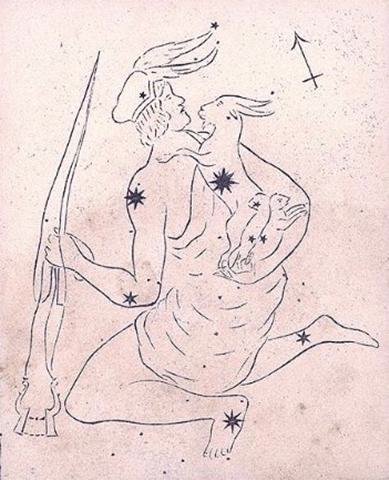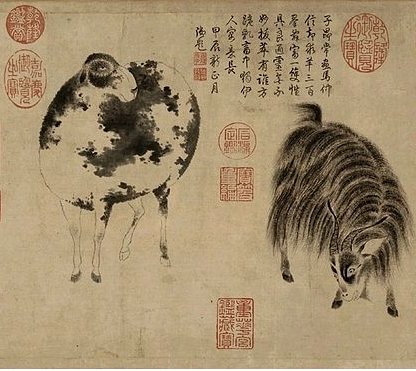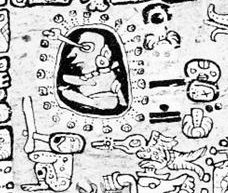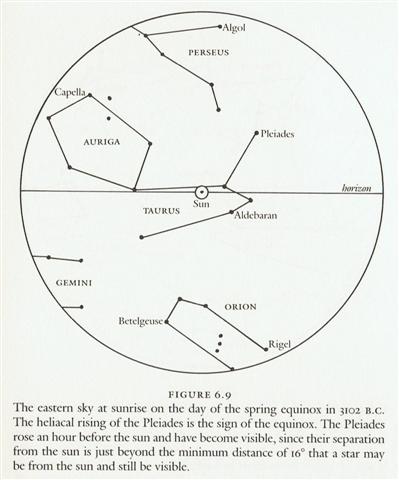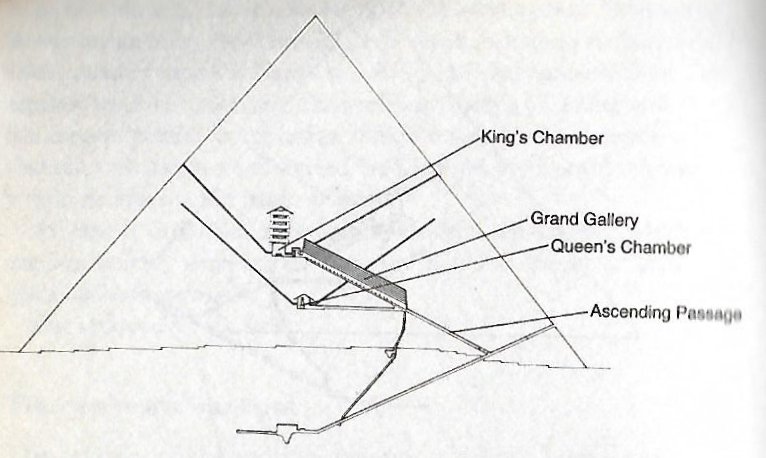Ba1.1 The beginning of the text on the B tablet was probably when - where in time-space - the Full Moon was (had been) at the 'Gate of the Goat' (Haedus I and II). ... In time-space (Pacha) everything was present simultaneously, for this was necessary when telling about the structure as a whole ... In the Golden Age of the Bull, this place had been (it was calculated) at the right ascension day number for the present June 4 (155 - 80 = *75) minus *64. Since the time of the Bull the precession had carried the cardinal points of the Sun 64 days earlier as observed against the positions of the fixed stars. I.e., *75 (June 4) - *64 (the effects of the precession) = *11 (APRIL 1, 80 + 11 = 91). For at the time of rongorongo Haedus II (η Aurigae) rose with the Sun in June 4 (155, *75) and 64 precessional days earlier this place had been 11 days after 0h corresponding to APRIL 1 (91, *11).
In December 4 (which south of the equator corresponded to June 4) the Full Moon could be observed at Haedus II. ... The tradition preserved by Hyginus in his Poetic Astronomy that the constellation Capricorn ('He-goat') was Zeus's foster-brother Aegipan, the Kid of the Goat Amalthea whose horn Zeus also placed among the stars, shows that Zeus was born at mid-winter when the Sun entered the house of Capricorn ...
The Moon could be observed in order to determine time.
... In ancient times the priest-astronomers (Brahmans) determined the recurrence of the solstices and equinoxes by the use of the gnomon. Later they developed the Nakshatra system of star reference to determine the recurrence of the seasons, much as the Greeks used the heliacal rising of some star for the same purpose. An example of the operation of the Nakshatra system in antiquity can be seen in figure 6.9.
Here we see that the spring equinox occurred when the sun was at its closest approach to the star Aldebaran (called Rohini by the Hindus) in our constellation Taurus. But, of course, the phenomenon would not have been visible because the star is too close to the sun for observation. The astronomers would have known, however, that the equinoctial point was at Aldebaran by observing the full moon falling near the expected date or near a point in the sky exactly opposite Aldebaran (since the full moon is 180º from the sun), that is, near the star Antares ... When the Full Moon was at right ascension day *75 (June 4, 155), then the Sun must be at the opposite side, viz. around December 4, 338, because *75 + *183 = *258.
The Rigel year should begin 3 days later, when the Full Moon was at the place corresponding to Capella (the Mother Goat) in June 7 (APRIL 4, 459 = 365 + 94). ... In view of the almost universal prevalence of the Pleiades year throughout the Polynesian area it is surprising to find that in the South Island and certain parts of the North Island of New Zealand and in the neighboring Chatham Islands, the year began with the new Moon after the yearly morning rising, not of the Pleiades, but of the star Rigel in Orion ... Instead of looking at the stars close to the Full Moon ( ○) it would have been more convenient to look at the completely dark face of the New Moon (●), when the stars in the background could be more easily perceived.Aue. Ah, alas. Aueue, oh. P Pau., Ta.: aue, alas. Mgv.: aue, auhe, alas. Mq.: aue, oh, alas; auhe, a sigh. Exclamation in general representing the most primordial type of speech, it seems that this may be reduced to recognizable elements. The e is throughout these languages a vocative or hailing sign, commonly postpositive in relation to the person hailed. In the examination of au we have shown that the primal first person singular designation is u. With the comparatively scanty material afforded by this vocabulary we may not attempt to define the use of a but we have no hesitation in noting that proof based on wider studies will show it to have, inter alia, a characteristic function as a word-maker. In a very high degree, then, a-u-e is represented by a common English interjection 'oh my!' in which oh = a, my = u, and e = !. Churchill. What is this cry which our primitive islanders share with the animals? Look at its elements, all full-throated. First we have a, the sound of mouth open, fauces open, lungs full of air. As air expires the sound recedes in the mouth towards the palate and we find the u. Last comes the conscious finish of the utterance, the muscles begin to retract, the sound-making point is forced forward and the sound is e. If the man had but a few more cubic centimeters of lung capacity he could attain cow volumne for his cry, or interjection, since it amounts to the same thing. Churchill 2. When the new moon appeared women assembled and bewailed those who had died since the last one, uttering the following lament: 'Alas! O moon! Thou has returned to life, but our departed beloved ones have not. Thou has bathed in the waiora a Tane, and had thy life renewed, but there is no fount to restore life to our departed ones. Alas ... Here (in early June) was also the culmination at 21h of Thuban, the star which in the Golden Age of the Bull had been at the North Pole:
... Allen has documented all his star culminations at 21h, which could be due to an effort of keeping the culminations at their proper places according to the ancients, 24h (spring equinox) - 21h = 3h = 24h / 8 = 45º. 3h corresponds to 366 / 8 = 45.75 of my right ascension days and *366 - *46 = *320 (Dramasa, σ Octantis) ... In order to better understand the fundamental structure the table below, beginning at Haedus II, should be studied:
There were 3 days after Haedus II and beyond Capella came right ascension day *79 which was the position of the northern spring equinox. ... Ecclesiastically, the equinox is reckoned to be on 21 March (even though the equinox occurs, astronomically speaking, on 20 March [*364] in most years) ... According to the Era of Bharani the corresponding day number would have been 118 (= 4 * 29½) for "April 28, which generates 118 + 182 = 300 ("Octob er 27) at ο Ophiuchi, 183 days after Mother Goat (Capella).
Cursa (β Eridani) was the Footstool of Orion:
|
|||||||||||||||||||||||||||||||||||||||||||||||||||||||||||||||||||||||||||||||||||||||||||||||||||||||||||||||||||
